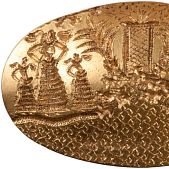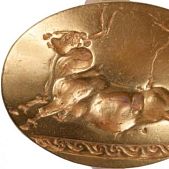
New findings from the 3,500-year-old tomb of a bronze age warrior
A trove of beautifully engraved gold rings and gemstones, found in the untouched grave of an ancient Greek warrior last year, were possessions from his culture, not loot from the nearby island of Crete, archaeologists now believe, according to New York Times. The gold rings, they say, were rings of power. These items served as insignia of the elite who ruled the local inhabitants of Pylos, the town on the southwestern coast of Greece where the warrior’s grave was found.
Archeologists say they have discovered the ‘real’ ‘Lord of the Rings’, after a 3,500-year-old ancient warrior’s skeleton was unearthed amid a treasure trove of ancient artifacts in Greece. The grave was discovered in the spring of 2015 by Jack L. Davis and Sharon R. Stocker, a husband-and-wife team at the University of Cincinnati who have been excavating at Pylos for 25 years.
The grave throws light on a dramatic historical process, the extension of the Minoan culture of Crete to southern Greece, where it formed the basis of Mycenaean civilization, the first in mainland Europe. Mycenaean rulers such as Achilles, Agamemnon and Odysseus were the heroes of Homer’s epics, and Mycenaean civilization, even though it collapsed shortly after 1200 B.C., was the forerunner of the classical Greek era that arose some 700 years later.
The grave was discovered last year by Jack L. Davis and Sharon R. Stocker, a husband-and-wife team at the University of Cincinnati, and is judged by other archaeologists to be one of the richest tombs to have been found in Greece in the last half-century. The warrior was buried around 1450 B.C., a date derived from pottery found around the grave. His facial appearance has been reconstructed from his skull by Lynne Schepartz and Tobias Houlton of the University of the Witwatersrand in Johannesburg.
The gold rings, engraved gemstones and many other items in the grave bear Minoan themes, so they could have been plunder from a raid on Crete. But Dr. Davis and Dr. Stocker believe otherwise, noting that objects in the grave are echoed in the iconography of the gold rings, they write in an article to be published in the journal Hesperia.
The grave contained a bronze mirror and six ivory combs, accessories the archaeologists were surprised to find in a warrior’s tomb. But Greek warriors wore their hair long, and Spartan warriors are known to have combed their hair before battle. And the mirror may have had a ritual significance: One of the gold rings depicts a goddess holding a similar mirror.
Another object both in the grave and shown on the rings is a staff. A twisted piece of metal found in the grave appeared at first to be a meat hook. But when untwisted it turned out to be the head of a horned animal, probably a bull, with a socket and nail hole as if to be mounted on a staff. A goddess is holding just such a staff on one of the gold rings.
The staff almost certainly indicates that the warrior held authority of some kind, religious or civil.
The archaeologists do not yet know if the warrior and those who buried him were Minoans or Mycenaeans steeped in Minoan culture.
“Whoever they are, they are the people introducing Minoan ways to the mainland and forging Mycenaean culture,” Dr. Davis said. “They were probably dressing like Minoans and building their houses according to styles used on Crete, using Minoan building techniques.”
The warrior’s grave “is telling us that right from the beginning there were people on the mainland who knew what Minoan culture meant and were bringing it to the mainland for a specific reason, that of establishing themselves in positions of power,” he said.
By 1400 B.C., half a century after the warrior’s death, that power had been extended to the province of Messenia and 20 district capitals, all paying taxes to their Mycenaean overlords, who ruled in Pylos from the so-called Palace of Nestor, named after the Homeric hero.
Cynthia W. Shelmerdine, an expert on the Aegean Bronze Age at the University of Texas, said she agreed that the rings and gemstone seals in the warrior’s grave represented administrative and political power. “These things clearly have a power connection,” she said, whether or not the rings were used in the Minoan way for sealing objects.
The grave, whether dug by Minoans or Mycenaeans, “fits with other evidence that the elites on the mainland are increasingly closely connected to the elites on Crete,” Dr. Shelmerdine said.
The Mycenaeans continued to use Minoan themes, such as gymnasts leaping over bulls, in their art and administration until the end of the palatial period. But by classical times the memory of Minoan culture had faded, and survived mostly in the myth of Ariadne, the daughter of King Minos, who showed Theseus how to kill the dreaded Minotaur and escape from the labyrinth at Knossos.
What he and Dr. Stocker had stumbled on was a very rare shaft grave, 5 feet deep, 4 feet wide and 8 long. Remarkably, the burial was intact apart from a one-ton stone, probably once the lid of the grave, which had fallen in and crushed the wooden coffin beneath. The coffin has long since decayed, but still remaining are the bones of a man about 30 to 35 years old and lying on his back. Placed to his left were weapons, including a long bronze sword with an ivory hilt clad in gold and a gold-hilted dagger. On his right side were four gold rings with fine Minoan carvings and some 50 Minoan seal stones carved with imagery of goddesses and bull jumpers. An ivory plaque carved with a griffin, a mythical animal that protected goddesses and kings, lay between the warrior’s legs. The grave contained gold, silver and bronze cups.The top of the warrior’s shaft grave lies at ground level, seemingly so easy to find that it is quite surprising the tomb lay intact for 35 centuries.Archaeologists expressed astonishment at the richness of the find and its potential for shedding light on the emergence of the Mycenaean civilization, the lost world of Agamemnon, Nestor, Odysseus and other heroes described in the epics of Homer. The warrior’s grave belongs to a time and place that give it special significance. He was buried around 1500 B.C., next to the site on Pylos on which, many years later, arose the palace of Nestor, a large administrative center that was destroyed in 1180 B.C., about the same time as Homer’s Troy. The palace was part of the Mycenaean civilization; from its ashes, classical Greek culture arose several centuries later. The palaces found at Mycene, Pylos and elsewhere on the Greek mainland have a common inspiration: All borrowed heavily from the Minoan civilization that arose on the large island of Crete, southeast of Pylos. The Minoans were culturally dominant to the Mycenaeans but were later overrun by them.










